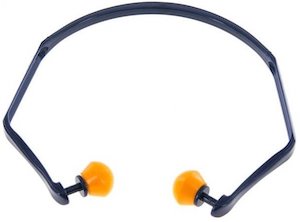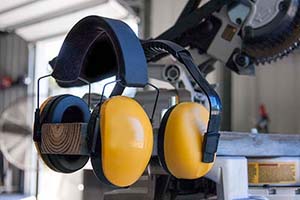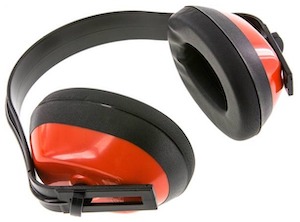Ear Protection Ensures Better Hearing Health
As the cases of noise-induced hearing loss (NIHL) rise, it is becoming more evident that ear protection is essential to maintaining healthy hearing. Exposure to loud noise leads to hearing loss, tinnitus, and other hearing challenges.
Hearing challenges are not limited to the elderly, according to World Health Organization (WHO) statistics, which report that more than 1 billion young adults are at risk of permanent, avoidable hearing loss due to unsafe listening practices. Whether your exposure to loud noise comes from work, social events, or something else, you can prevent damage to your ears by using ear protection.
View our online selection of personal protective equipment!
Why do you need ear protection?
According to the Occupational Safety Health Administration (OSHA), a person exposed to a sound intensity of 90 decibels (dB) or more in their workplace for 8 hours will see damage to their hearing. As well, a 2012 Central Institute for Labour Protection study of the risks of noise-induced hearing loss in Poland and other European countries suggests that the limit of sound intensity your ears can endure without damage is 80-85 dB.
In 1976, the International Labour Organization established that for each increase of 3 dB, the amount of time without doing damage to your ears should be cut in half, while OSHA indicates the same amount of time with each increase of 5 dB. In essence, exposure to 90 dB for more than 8 hours without protection could cause hearing loss.
While normal conversation takes place at around 60 dB, operating a lawnmower or belt sander exposes you to about 90 dB. At 107 to 110 dB, using heavy equipment or a chainsaw for an hour without ear protection will cause damage to your hearing. Meanwhile, a jet engine can damage your ears in less than a minute.
Like OSHA, occupational safety organizations like the International Labour Organization, Central Institute for Labor Protection, Australia's OHS, Canada's OHS, and EU-OSHA require employers to provide ear protection on the job. Still, most people downplay the importance of protecting your ears during everyday activities. While the figures above focus primarily on NIHL risks in industrial settings, consider some non-industrial noise levels:
- Movie theatre 74 -104 dB
- Motorcycles/Dirt bikes 80 - 110 dB
- Headphones (max volume), sporting events, nightclubs, concerts 94 - 110 dB
- Sirens/Alarms 110 - 129 dB
- Fireworks 140 - 160 dB
Selection criteria for ear protection
There are three primary considerations to keep in mind when choosing ear protection:
Protective qualities
Regulating agencies worldwide require ear protection products to come with a noise attenuation value, SNR (single number rating) in EU countries, and NRR (noise reduction rating) in the US. The rating is designed to indicate the amount of noise reaching your ears when the product is worn. For example, 20 dB rated ear protection in a 110 dB noise environment will lower your noise exposure to 90 dB (110 - 20 = 90 dB).
Application environment
Along with environmental noise, it is necessary to consider how ear protection might affect the work or activity you're engaged in and how the job or training might affect the performance of ear protection. For example, earmuffs might be too bulky or become damaged in one environment while providing the best protection in another. Environmental factors can include:
- Adjustability/Comfort
- Temperature/Humidity/Moisture resistance
- Allow for audible communication
- Corded or cordless
- Material durability
Personal preferences
To choose the ear protection that fits your needs, consider what you can afford and what feels comfortable. As well, the level of quality you demand, disposable vs. reusable, earmuffs vs. earplugs, material type, and color or design choice may be worth exploring.
Types of ear protection
Expandable foam earplugs
This type of earplug uses formable material capable of expanding and conforming to a person's ear canal shape. To use, roll the foam into a cylinder that is thin enough to fit about half its length into your ear canal. This type of earplug is less expensive than other types and is discarded after one use.
Pre-molded, reusable earplugs

Figure 2: Banded ear plugs
Common materials used to make pre-molded plugs are silicone, plastic, or rubber. These products come as "one-size-fits-most" or are in small, medium, and larger sizes. Because sealing the ear canal without discomfort is the primary objective of this earplug, sizing is important.
Pre-molded plugs differ in the number of flanges, whether posts or loops are used for insertion, whether they come with a solid band (canal caps) or lanyard between the pair, as well as their varying levels of noise attenuation. Pre-molded plugs are relatively inexpensive, reusable, washable, convenient to carry, lightweight, and come in a variety of sizes. They help overcome the clumsiness of earmuffs while providing ear protection in dusty or high-moisture environments.Noise control or electronic earplugs
This style of earplug provides both noise attenuation and sound processing. Musicians, hunters, and others require ear protection from loud noise but don't want the tone quality or environmental sounds around them to be muffled. They use noise reduction technology common to hearing aids to limit the noise intensity while preserving the tone and quality of sounds.
Earmuffs
Earmuffs will fit most people because they have an adjustable headband and block noise by covering the entire ear. High-end earmuffs can contain noise reduction and sound processing. They come in low-profile designs with smaller ear cups or additional sound dampening materials in a larger cup.
They can be hot, bulky, and heavy for some situations and may not be the best choice for some applications or users wearing glasses. Still, various types facilitate communication, like those used by aircraft pilots.

Figure 3: Ear muffs personal protective equipment
Applications
- Construction
- Manufacturing
- Musicians
- Security/Bodyguards
- Shooting sports/Hunting
- Concerts
- Sporting events
- Lawn and garden
- Workshop
- Logging/sawmills
- Operating heavy equipment
Conclusion
Noise-induced hearing loss is a significant health issue that affects individuals of all ages. Regardless of whether your exposure to loud noise comes from work, social or sporting events, leisure activities, or hobbies, prevent the damage that causes hearing loss, tinnitus, and other hearing challenges with some form of ear protection. Always keep in mind that hearing protection is only a small part of your personal protection, items such as eye protection and protective clothing are equally important.














